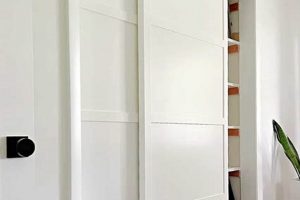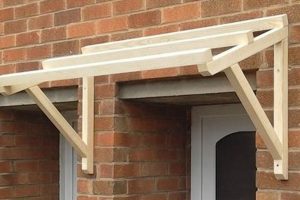The practice of independently installing decorative trim around door frames is a common home improvement activity. This process typically involves selecting a molding profile, precisely measuring and cutting the trim pieces, and then affixing them to the door frame with nails, adhesive, or a combination of both. An example would be a homeowner choosing to install a simple colonial-style molding around an interior door as a weekend project.
Undertaking such projects offers several advantages, including cost savings compared to professional installation and the satisfaction of completing a home improvement task. Historically, this type of work was often a necessity for homeowners, but today it remains a popular choice for those seeking to personalize their living spaces or increase property value. The addition of well-chosen trim can significantly enhance the aesthetic appeal of a room.
Subsequent sections will detail specific molding types, essential tools, step-by-step installation techniques, and common challenges encountered during the installation process. This will equip individuals with the knowledge to confidently approach the task and achieve professional-looking results.
Essential Considerations for Trim Installation
The following guidelines provide critical insights to ensure successful and aesthetically pleasing decorative trim installation around doors. Careful adherence to these points will mitigate common errors and contribute to a professional finish.
Tip 1: Material Selection. Selecting appropriate materials is paramount. Consider the environment in which the trim will be installed. High-moisture areas, such as bathrooms, necessitate moisture-resistant materials like PVC. For painting, primed wood or MDF are suitable choices.
Tip 2: Accurate Measurement. Precise measurements are crucial for seamless joints. Measure each side of the door frame individually. Account for the miter angle of the trim pieces, typically 45 degrees for corners, and ensure accurate cuts. Inaccurate measurements will result in gaps or misaligned corners.
Tip 3: Miter Joint Precision. The quality of miter joints directly impacts the overall appearance. A miter saw is recommended for creating clean, precise cuts. Test-fit the mitered pieces before applying adhesive or fasteners. Fine-tuning with a block plane or sandpaper may be necessary to achieve a tight, gap-free fit.
Tip 4: Secure Fastening. Proper fastening ensures the trim remains securely attached. Use finishing nails or a nail gun with appropriate nail size for the trim and wall material. Apply construction adhesive along the back of the trim for added stability, particularly when attaching to uneven surfaces. Countersink nails and fill the holes for a smooth finish.
Tip 5: Caulk Application. Caulk fills gaps between the trim and the wall, creating a seamless transition and preventing moisture intrusion. Apply a thin, consistent bead of paintable caulk along the edges of the trim. Smooth the caulk with a wet finger or a specialized caulking tool for a clean, professional look. Remove excess caulk immediately to avoid a messy finish.
Tip 6: Consistent Reveal. Maintain a consistent reveal, or the amount of door frame visible beyond the trim, for a balanced aesthetic. Use shims or spacers to ensure the trim is consistently positioned around the door frame. This creates a visually appealing and professional finish.
Tip 7: Addressing Imperfections. Minor imperfections in the wall or door frame can impact the trim installation. Use shims to compensate for uneven walls and a wood filler to repair minor damage to the door frame. A thorough inspection of the surfaces prior to installation will identify potential issues.
Tip 8: Planning and Preparation. Adequate planning and preparation are fundamental. Gather all necessary tools and materials before commencing the project. Protect the surrounding area with drop cloths. Thoroughly clean the door frame and wall surfaces to ensure proper adhesion. A well-prepared work area streamlines the process and minimizes errors.
Adhering to these guidelines promotes accuracy, durability, and a refined aesthetic. Success hinges on careful planning, precise execution, and meticulous attention to detail.
The subsequent section concludes the discussion and offers additional considerations.
1. Precise Measurements
The accurate determination of dimensions constitutes a foundational element within independent decorative trim installation around doors. Within the context of decorative trim installation, precise measurements directly influence the fit and finish of the installed product. Deviations from accurate dimensions necessitate remedial measures, potentially increasing material waste and project duration. For instance, inaccurate measurements may result in miter joints that do not align properly, creating visible gaps and diminishing the aesthetic quality of the installation. The ramifications of imprecise measurements extend beyond visual imperfections to potentially compromise the structural integrity of the trim installation.
The process of obtaining accurate measurements requires meticulous attention to detail. Consideration must be given to the specific profile of the molding being installed, as well as any existing architectural features that may impact the trim’s placement. The use of reliable measuring tools, such as a precision tape measure and a level, is essential. Furthermore, a comprehensive understanding of miter angles and the application of appropriate mathematical formulas is critical for achieving seamless corner joints. For example, determining the correct length for a piece of trim that forms a 90-degree corner requires accounting for the miter angle of 45 degrees on each adjoining piece. Failure to account for these factors will inevitably lead to dimensional inaccuracies.
In summation, the acquisition of precise measurements serves as a cornerstone for the success of any decorative trim installation endeavor. Emphasizing precision throughout the measurement process minimizes the likelihood of errors, reduces material waste, and contributes to an aesthetically pleasing and structurally sound final product. Challenges in obtaining accurate measurements, such as dealing with uneven walls or complex architectural details, require careful consideration and potentially the application of specialized techniques. Ultimately, mastering the art of precise measurement is indispensable for individuals undertaking decorative trim installation projects.
2. Proper miter cuts
In the realm of independent decorative trim installation around doors, the execution of accurate miter cuts stands as a pivotal determinant of project success. The confluence of precisely angled cuts forms the foundation for seamless corner transitions, directly impacting the overall aesthetic and structural integrity of the finished product.
- The Role of Angle Accuracy
Miter cuts, typically performed at a 45-degree angle for 90-degree corners, necessitate exacting precision. Deviations from the intended angle, even by a fraction of a degree, manifest as visible gaps or misalignments at the joint. In a practical example, a slightly obtuse miter cut results in an open corner, requiring filler and potentially diminishing the professional appearance. Accurate angular cuts are therefore indispensable for creating tightly fitted, visually appealing corners.
- Tools and Techniques
Achieving proper miter cuts demands the use of appropriate tools and techniques. A powered miter saw, equipped with a sharp blade, provides the precision and control required for consistent, clean cuts. Manual miter boxes, while less expensive, necessitate a higher degree of operator skill to achieve comparable accuracy. Regardless of the tool employed, a secure workpiece clamping system is essential to prevent movement during the cutting process, minimizing the risk of error.
- Material Considerations
The material composition of the trim directly impacts the ease and accuracy of miter cuts. Softer woods, such as pine, are generally more forgiving and easier to cut cleanly, while hardwoods may require slower feed rates and sharper blades to prevent splintering. Composite materials, such as MDF, can produce significant dust during cutting, necessitating proper ventilation and personal protective equipment. Understanding the properties of the chosen material is crucial for optimizing the cutting process and minimizing imperfections.
- The Impact on Visual Appeal
The quality of miter cuts exerts a profound influence on the visual impact of the installed decorative trim. Precisely executed miters create a seamless, continuous line, enhancing the perceived quality and craftsmanship of the installation. Conversely, poorly executed miters detract from the overall appearance, drawing attention to imperfections and undermining the intended aesthetic effect. In essence, the precision of miter cuts serves as a visual indicator of the installer’s skill and attention to detail.
In summary, the successful integration of decorative trim around doors relies heavily on the execution of proper miter cuts. These cuts, demanding precision, appropriate tools, and an understanding of material properties, directly influence the visual appeal and overall quality of the finished installation. Mastering the art of miter cutting is therefore a fundamental skill for anyone undertaking such projects.
3. Secure Attachment
In the context of decorative trim installation around doors, secure attachment represents a critical factor influencing the longevity, stability, and overall appearance of the finished product. It functions as the primary mechanism by which the trim remains affixed to the doorframe and surrounding wall surfaces, with inadequate adherence leading to premature failure and aesthetic degradation. A fundamental understanding of secure attachment principles is, therefore, indispensable for individuals engaging in such projects.
The relationship between secure attachment and successful trim installation manifests as a clear cause-and-effect dynamic. Insufficient fastening, whether due to the use of inadequate adhesive, improperly sized nails, or failure to adequately prepare the surfaces, results in loose or detached trim. This not only detracts from the aesthetic appeal but also creates potential safety hazards. Conversely, robust and appropriate attachment methods ensure the trim remains firmly in place, maintaining its intended appearance and contributing to the structural integrity of the doorframe. A real-life example involves the use of construction adhesive in conjunction with finishing nails. The adhesive provides a continuous bond along the trim’s surface, while the nails offer immediate holding power, particularly crucial for curved or complex trim profiles. The adhesive compensates for minor imperfections in the wall surface, ensuring a uniform and secure bond.
Challenges associated with achieving secure attachment often arise from variations in wall and doorframe materials. Plaster walls, for instance, may require specialized fasteners or adhesive formulations compared to drywall. Likewise, the presence of old paint or wallpaper can impede adhesion. Addressing these challenges requires a thorough assessment of the substrate materials and the selection of appropriate attachment methods. Ultimately, prioritizing secure attachment ensures a durable, visually appealing, and safe decorative trim installation. It is a cornerstone of successful completion, complementing precise measurements and accurate miter cuts to achieve a professional-grade result.
4. Seamless caulking
Within the context of independent decorative trim installation around doors, seamless caulking represents a critical finishing process. This procedure mitigates gaps between the installed trim and adjacent surfaces, contributing significantly to both the aesthetic and functional integrity of the final result.
- Aesthetic Enhancement
The primary function of caulking is to create a visually continuous transition between the trim and the wall or doorframe. Eliminating visible seams and imperfections enhances the perceived quality of the installation. For instance, a small gap between the trim and an uneven wall surface, if left uncaulked, will be readily apparent and detract from the overall appearance. A properly applied bead of caulk, smoothed to a seamless finish, creates a professional and polished look.
- Moisture Barrier
Beyond aesthetics, caulking serves as a crucial barrier against moisture intrusion. Gaps between the trim and adjacent surfaces can allow water to penetrate, potentially leading to mold growth, wood rot, and structural damage. In areas prone to humidity or direct water exposure, such as bathrooms, this protective function is particularly important. A continuous bead of caulk, properly bonded to both surfaces, effectively seals these potential entry points.
- Surface Preparation and Caulk Selection
Achieving seamless caulking requires careful surface preparation. Surfaces must be clean, dry, and free from loose debris. The choice of caulk is also critical. Paintable acrylic latex caulk is generally suitable for interior trim applications, offering good adhesion and flexibility. Silicone-based caulks, while more water-resistant, are less readily paintable and may be more appropriate for areas subject to frequent moisture exposure.
- Application Techniques
Effective caulking relies on proper application techniques. A consistent bead of caulk should be applied along the joint, avoiding excessive amounts that can lead to a messy finish. The caulk should then be smoothed with a wet finger or a specialized caulking tool to create a seamless transition. Excess caulk should be removed immediately to prevent unsightly residue. A steady hand and careful attention to detail are essential for achieving a professional-looking result.
The successful integration of decorative trim around doors hinges, in part, on the skillful execution of seamless caulking. This process, demanding attention to detail and appropriate materials, contributes significantly to the aesthetic appeal, moisture resistance, and overall longevity of the installation.
5. Aesthetic Consistency
The application of decorative trim around doors, when undertaken independently, necessitates careful consideration of aesthetic consistency. This principle ensures the newly installed trim harmonizes with existing architectural elements, contributing to a cohesive and visually pleasing interior design.
- Style Matching
Selecting a trim style that complements the existing architectural character is paramount. Colonial homes, for instance, typically benefit from simple, elegant trim profiles, while Victorian-era residences often feature more ornate designs. The incongruous application of modern, minimalist trim in a historically styled home would disrupt the established aesthetic. Conversely, the use of overly elaborate trim in a contemporary setting can appear out of place. Thoroughly assessing the prevailing architectural style facilitates informed trim selection.
- Color Harmony
The color of the decorative trim should align with the overall color scheme of the room. While exact matching is not always necessary, the chosen color should complement the wall color, door color, and other existing trim elements. A stark contrast between the new trim and the surrounding surfaces can create a jarring effect, diminishing the aesthetic appeal. In a room with warm-toned walls, a trim color with similar undertones would generally be more harmonious than a cool-toned color.
- Scale and Proportion
The size and proportions of the trim should be appropriate for the size of the door and the overall dimensions of the room. Overly large trim can overwhelm a small space, while undersized trim may appear insignificant. The width of the trim should be proportionate to the height of the door and the height of the ceiling. Furthermore, the spacing between the trim and other architectural elements should be consistent to maintain visual balance.
- Material Consistency
Maintaining consistency in materials, where feasible, contributes to a unified aesthetic. If existing trim throughout the home is constructed from a specific type of wood or composite material, replicating that material for the door trim helps to maintain visual continuity. While budget constraints or availability may necessitate alternative materials, careful consideration should be given to matching the texture and finish as closely as possible.
Adherence to these principles of aesthetic consistency ensures that independently installed decorative trim enhances the overall visual appeal of the interior space. By carefully considering style, color, scale, and material, individuals can achieve a seamless and harmonious integration of the new trim, contributing to a cohesive and aesthetically pleasing environment.
Frequently Asked Questions
The following addresses common inquiries regarding the independent installation of decorative trim around door frames. These questions aim to clarify typical challenges and provide guidance for a successful installation.
Question 1: What is the recommended tool for cutting mitered corners in door molding?
A powered miter saw offers the most precise and efficient means for cutting mitered corners. Its adjustable angle settings and blade control provide accurate cuts essential for seamless corner joints. While a manual miter box can be used, it requires greater skill and precision to achieve comparable results.
Question 2: What type of adhesive is best suited for adhering door molding to the doorframe?
Construction adhesive, specifically formulated for trim and molding applications, provides a strong and durable bond. Ensure the selected adhesive is compatible with both the molding material and the doorframe surface. Apply the adhesive in a continuous bead along the back of the molding for optimal adhesion.
Question 3: How can gaps between the door molding and the wall be effectively concealed?
Paintable acrylic latex caulk is recommended for filling gaps between the door molding and the wall. Apply a thin, consistent bead of caulk along the seams and smooth it with a wet finger or caulking tool. Ensure the caulk is fully dry before painting to prevent cracking or discoloration.
Question 4: What is the proper method for attaching door molding to a plaster wall?
Plaster walls require specialized fasteners to ensure secure attachment. Consider using plaster screws or construction adhesive specifically designed for plaster surfaces. Pre-drilling pilot holes can prevent the plaster from cracking during installation. Exercise caution to avoid damaging the plaster during the fastening process.
Question 5: How can a consistent reveal be maintained when installing door molding?
Utilize shims or spacers to ensure the trim is consistently positioned around the doorframe. Measure the desired reveal the amount of doorframe visible beyond the trim and cut shims to that thickness. Place the shims behind the molding during installation to maintain a uniform reveal.
Question 6: What is the recommended method for concealing nail holes in door molding?
Wood filler or spackle can be used to conceal nail holes. Apply a small amount of filler to each hole, ensuring it is flush with the surface of the molding. Allow the filler to dry completely before sanding it smooth. Prime and paint the filled areas to match the surrounding molding.
The information provided addresses several key areas of concern related to installing trim independently. The successful application of these techniques significantly contributes to the attainment of professional-quality results.
The subsequent section concludes the discussion and offers some important points to bear in mind.
Door Molding DIY
The foregoing analysis has illuminated critical facets of independent decorative trim installation around door frames. Accurate measurement, proper miter cuts, secure attachment, seamless caulking, and aesthetic consistency represent fundamental elements in achieving a professional outcome. Mastery of these techniques directly influences the durability, visual appeal, and overall value of the finished product.
Successful execution demands diligence, precision, and a thorough understanding of material properties and installation methodologies. As homeowners increasingly seek cost-effective home improvement solutions, a firm grasp of these principles will prove invaluable in enhancing the aesthetic character and long-term value of residential properties. The information provided serves as a foundation for informed decision-making and skillful execution.







